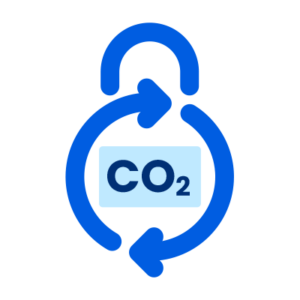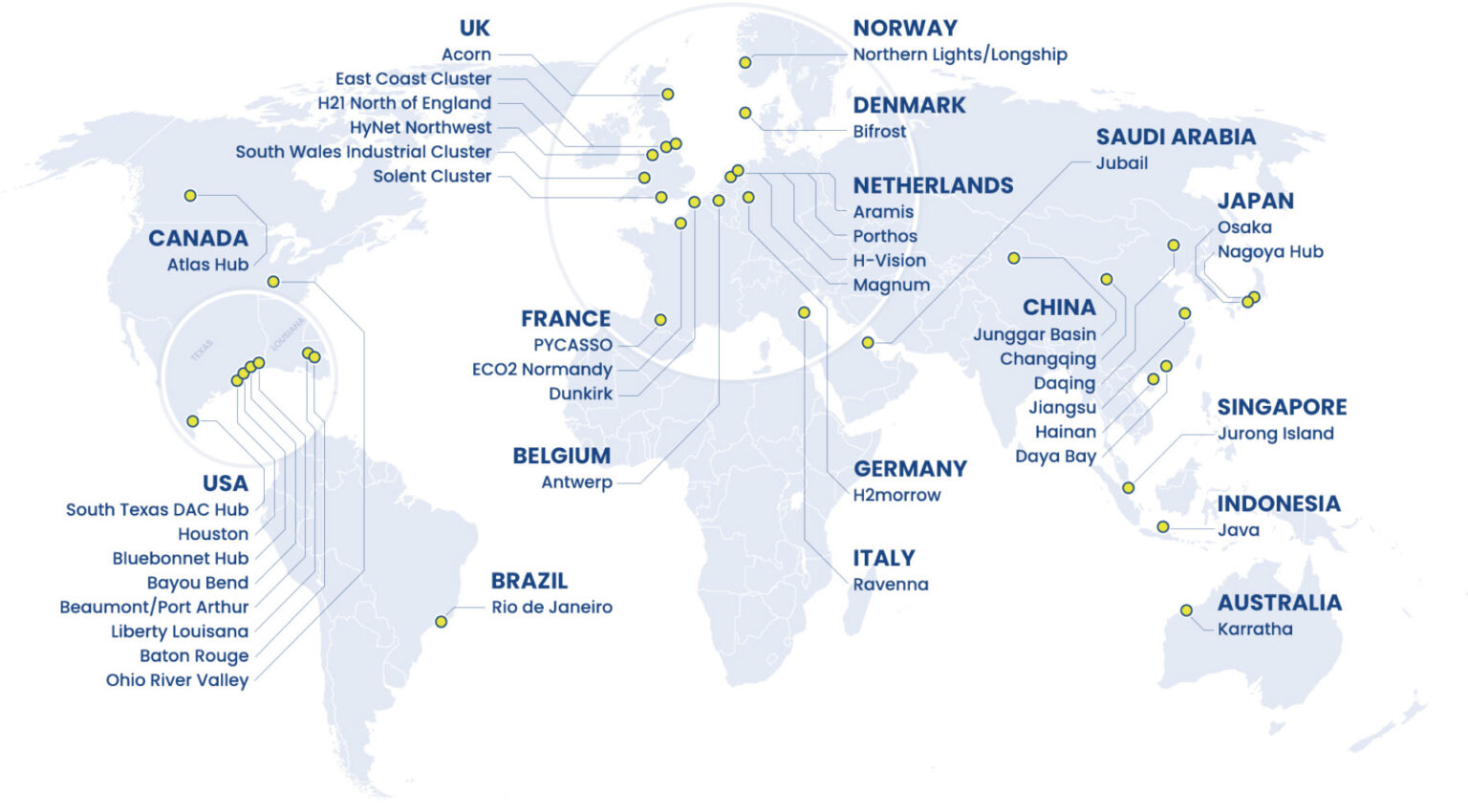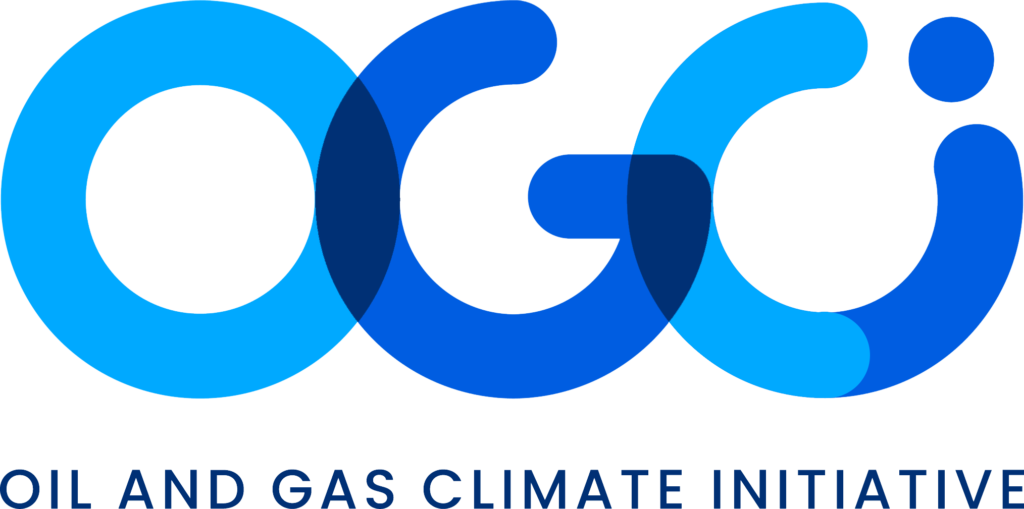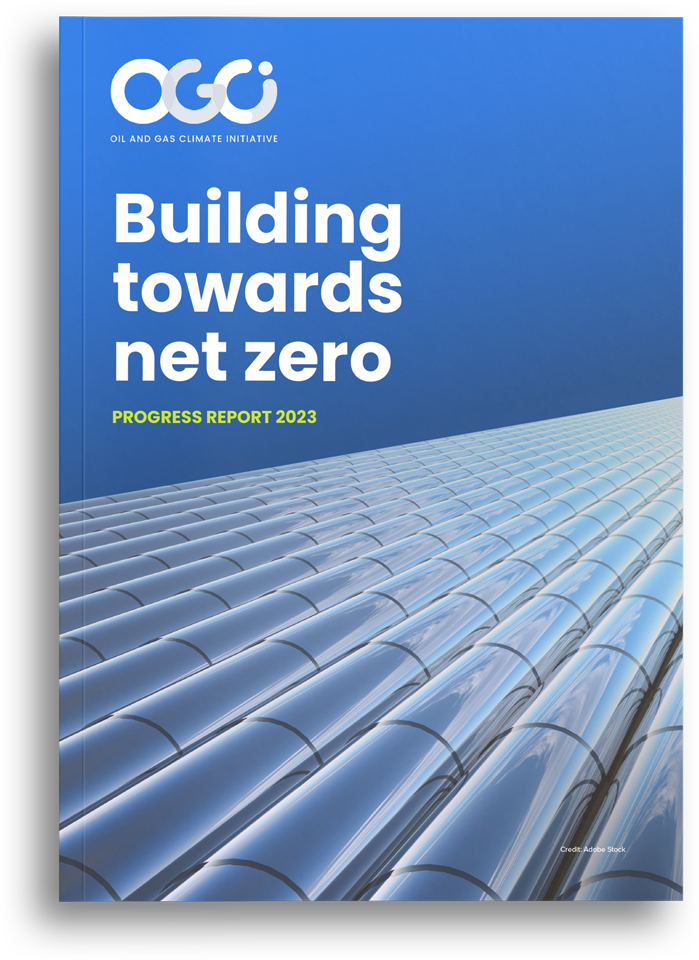The role of carbon capture, utilization and storage (CCUS) in tackling the global decarbonization challenge has advanced since OGCI was founded in 2014.
Leading institutions, including the UN’s Intergovernmental Panel on Climate Change (IPCC) and the International Energy Agency (IEA), recognize the role of CCUS in reducing carbon dioxide emissions and achieving net-zero greenhouse gas emissions cost effectively.
CCUS is now widely viewed as an essential technology that can decarbonize hard-to-abate industries such as steel, chemicals and cement. It can also enable the production of lower-carbon fuels and products such as hydrogen, and help decarbonize parts of the power sector.
The build out of CCUS infrastructure will also support the deployment of carbon dioxide removal technologies such as bioenergy with CCS (BECCS) and direct air capture with storage (DACS) that can help address existing and historic greenhouse gas emissions to achieve net zero.
Today, OGCI members have integrated CCUS into emerging carbon management business models that can help decarbonize their own refining and chemical businesses while also helping their industrial customers reduce emissions. Using the language of carbon accounting, CCUS helps to address Scope 1, 2 and 3 emissions.
In the years that OGCI has been working on CCUS, the landscape has changed significantly.
“We’re working to scale up CCUS, which will play an important role in supporting the goals of the Paris Agreement by helping to decarbonize industrial sectors where emissions are harder to abate such as cement, chemicals and steel.”
Julien Perez,
OGCI Vice President Strategy & Policy

A decade ago, the technology was generally viewed as an expensive way of decarbonizing the power sector and it was struggling to attract support as the cost of using renewables to generate power fell.
And there was little collaboration across industries, policymakers and other stakeholders on policy frameworks and business models.
The shift in perception has come about as OGCI and other organizations have worked to help the industry broaden its approach to include the build out of large interconnected regional CCUS hubs that can store emissions from multiple different high-emitting industries using shared transport and storage infrastructure.
The CCUS hub approach can help reduce risks, including technical, project management and financial, by working across sectors and scaling up ambitions to achieve economies of scale.
Spreading the cost of transport and storage infrastructure across more tonnes of carbon dioxide can reduce costs for the entire CCUS value chain.
Sharing transportation and storage infrastructure run by an emerging ecosystem of carbon dioxide management companies helps to accelerate and scale up development.
This in turn helps support the decarbonization efforts of industrial companies – and entire industrial regions.
Based on current plans there are about 100 CCUS hubs1 in development globally. These CCUS hubs could store an average of between 7.5-10 million tonnes of CO2 a year each by 2030. This could total as much as 1 gigatonne of CO2 in 2030.2
This is equivalent to shutting down almost 270 coal power plants or removing the emissions of 223 million gasoline-fueled cars.3
CCUS hubs can also add value by sustaining employment in traditional industries such as steel and cement as well as creating jobs in new low-carbon technologies and services, sustaining economic activity for these regions.
OGCI has played a vital role in demonstrating the value of CCUS as a key contributor to global efforts to reduce carbon dioxide emissions.
This, and our close work with national and regional stakeholders, including industry, NGOs and investors, has helped accelerate the development of CCUS hubs.
Kickstarting CCUS
OGCI member companies are now actively involved in developing 40 large-scale CCUS hubs around the world – up from less than five in 2019.
This is a significant percentage of the well over 100 CCUS hubs the IEA says are proposed or in development around the world4 – three times as many as in 2021.
The hubs OGCI members are involved in have the potential to remove around 300 million tonnes of CO2 a year by 20305, equivalent to shutting down 80 coal power plants or removing the emissions of around 67 million cars.6
Oil and gas companies have the core skills to successfully develop and operate CCUS hubs, stemming from experience executing complex projects, a deep understanding of the subsurface, and a long history of driving technological innovation.
In recent years, many oil and gas companies have worked on different elements of carbon capture and storage technologies – from retrofitting capture units to carbon dioxide streams in industrial and chemical processes to injecting carbon dioxide into depleting reservoirs and saline aquifers.
OGCI’s activities were designed to build on this foundation.
The first investment made by OGCI’s Climate Investment fund laid the groundwork for what would later become known as Net Zero Teesside, a commercial-scale CCUS hub designed to decarbonize industrial and power emitters in Northern England.
Now part of the UK’s East Coast Cluster and recently selected as one of the UK government’s fast track projects, the hub is on track to store approximately 20 million tonnes of CO2 a year by 2030 – a significant achievement for a project that started out as an academic concept.
The hub is anchored by the world’s first commercial scale gas-fired power station with carbon capture. OGCI and a dedicated team of engineers and project specialists from six of our member companies, were instrumental in the development of this project.
We helped to advise and build on collaboration between the UK government and a broad swath of industry stakeholders to develop new business models, manage risk, and explore ways to make CCUS more affordable.
This work helped to define policy to support capture in power, industry, hydrogen and biomass, and clarify regulations around storage infrastructure.
It ultimately culminated in a UK government-led task force highlighting in 2018 the significant value that CCUS hubs can bring to spur regional economic activity and job creation, and decarbonize industry to help meet national climate goals.7
That support, along with the presence of operators willing to invest long term, attracted interest from potential emitters who wanted to join the hub.
Momentum continues to grow in the UK as more emitters and investors look to engage in the country’s ambitious CCUS hub strategy.
OGCI's efforts to kickstart a CCUS industry include:
- Identifying policy mechanisms and frameworks that support new business models for emitters to capture their emissions and hub operators to create the infrastructure to transport and store them permanently
- Working with governments, academia and industry in countries with an interest in leveraging CCUS hubs to produce in-depth reports that provide a pathway for CCUS hub development8
- Developing methodologies to quantify the availability and maturity of carbon storage resources around the world
- Publishing an annually updated CO2 Storage Resource Catalogue that currently assesses commercial availability in some 30 countries – providing assurance to companies, regulators, financial institutions and others wanting to make investments in CCUS projects.
- Creating an interactive global hub search tool to identify potentially viable hubs around the world, looking at storage options, concentrations of emitters, transport options and costs
- Sharing knowledge and expertise developed by the first pioneering hubs through an online playbook, to help stakeholders work through the complexities of setting up a CCUS hub and running webinars with experts.
Progress in 2023
CCUS Hub Playbook update
This year, we updated the CCUS Hub Playbook, a step-by-step guide for regulators, emitters and CO2 transport and storage operators seeking to decarbonize industry at scale.
The update adds sections on policy incentives by country, an overview of how different hard-to-abate sectors are using CCUS to decarbonize and latest CCUS hub trends in the US, Europe and Asia-Pacific.
The playbook is now available online in 11 languages – Arabic, Chinese, French, Hindi, Indonesian, Italian, Japanese, Portuguese, Russian, Spanish and English.
Technical lessons
We’re currently working on a new section on the CCUS Hub platform for technical experts that is designed to help accelerate the pace of CCUS by sharing relevant experience from early movers.
This section will set out lessons learned from leading hubs and projects and share vital information on assessing and mitigating potential mechanical and process risks that could slow the development of a CCUS project.
This is based on detailed technical material. The first material covered is from Net Zero Teesside and focuses on storage issues and the technology development required for scale up.
Additional material is based on other CCUS hubs, some of which are in development.
The U in CCUS
OGCI is publishing a study on the potential for utilizing captured carbon dioxide as a climate mitigation tool. It includes an analysis of the value of using carbon dioxide in the construction industry as a way to cure cement and as a feedstock to produce fuels.
Region and country reports
Forthcoming reports will focus on the potential for CCUS hubs in Egypt, India, Asia-Pacific and Brazil.
The report on Brazil aims to research and evaluate the potential opportunities and challenges of developing a major CCUS hub in South America.
Opportunities in Brazil
- Decarbonizing Brazil’s iron, steel and ethanol industries could help these sectors retain and increase global market share.
- The study suggests that CCUS hubs could spur billions of dollars in GDP growth and help create thousands of new jobs.
- Data points to a number of locations where a significant amount of CO2 could be stored, including two potential offshore reservoirs in the southeast.
- Brazil can look to overseas models for policy frameworks that foster CCUS development, including via tax and fiscal policy and R&D support.
Calculating the value of CCUS
OGCI is creating an interactive tool to calculate the value of CCUS in terms of jobs and gross value added in specific regions. The tool is based on a methodology developed by Imperial College London.
It will initially cover regions in the UK, using up-to-date economic data and filtered by industry and capture technology used.
The aim is to develop a standardized methodology that can be used globally across the entire capture, transport and storage value chain to demonstrate the benefits of CCUS projects to local communities.
This can help companies engage with their stakeholders and policy makers potentially enabling the acceleration of projects.
- According to the IEA’s CCUS Projects Explorer
- Based on reported CCUS projects which average 7.5-10 mt each. See CCUS Hub
- Calculated using the US EPA GHG equivalencies calculator
- According to the IEA’s CCUS Projects Explorer
- Based on reported CCUS projects which average 7.5-10 mt each. See CCUS Hub.
- According to the IEA’s CCUS Projects Explorer
- Source: UK Department for Energy Security and Net Zero and Department for Business, Energy & Industrial Strategy’s “Delivering clean growth: CCUS Cost Challenge Taskforce report” (July 2018)
- OGCI published a report on CCUS deployment challenges and opportunities for the GCC in March 2022 and a report on CCUS in China in September 2021











